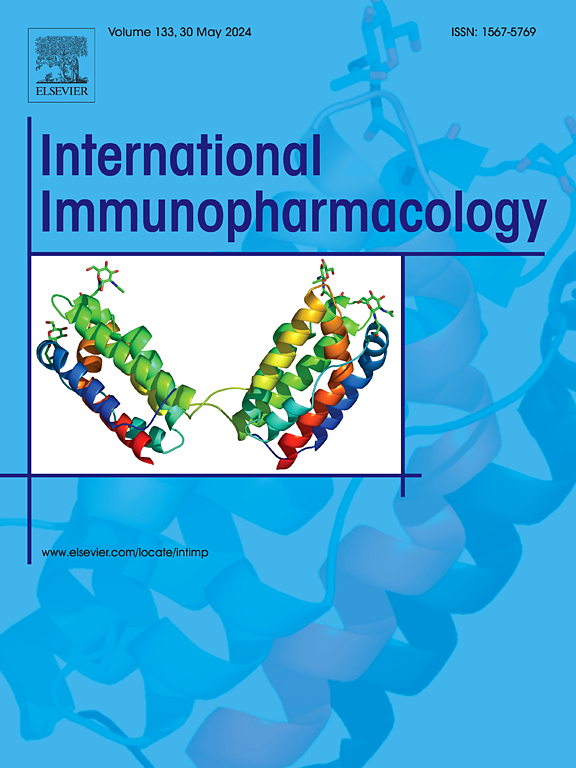The protective effects of water-soluble non-starch polysaccharides from Arctium lappa on LPS-induced acute lung injury in vitro and in vivo
IF 4.7
2区 医学
Q2 IMMUNOLOGY
引用次数: 0
Abstract
The lung, a fragile yet crucial organ for breathing in humans, is susceptible to harm from harmful external elements. This study advances the extraction of Arctium lappa polysaccharide (ALP) by our team, aiming to broaden the possibilities for novel medications targeting lung conditions. The structure of ALP was further analyzed by congo red analysis. Effect of ALP pre-treatment was checked by assessing antioxidant markers, inflammatory cytokines and antiapoptosis in vitro and in vivo. Congo red analysis showed that ALP had a stable three-helical conformation. ALP conferred protection against acute lung injury (ALI) induced by lipopolysaccharide (LPS) through the attenuation of lung tissue injury and inhibition of cell apoptosis. The apoptosis rate in lung tissues was markedly reduced in ALP-treated groups compared to the LPS group (P < 0.01). This protective effect is primarily attributed to dual mechanisms: the suppression of inflammatory cytokine synthesis and the enhancement of antioxidant responses. ALP significantly reduced the levels of LPS-induced inflammatory cytokines (P < 0.05) including tumor necrosis factor-alpha (TNF-α), interleukin-6 (IL-6) and interleukin-1β (IL-1β) in vitro and in vivo experiments. In addition, ALP alleviated LPS-induced lung injury by reducing malondialdehyde (MDA) and upregulating superoxide dismutase (SOD), glutathione peroxidase (GSH-Px), catalase (CAT), and the overall antioxidant capacity (T-AOC) contents. The western blot analysis of mice lung tissues revealed that ALP pretreatment significantly attenuated the LPS-induced upregulation of key inflammatory signaling proteins (P < 0.05), including TLR4, MyD88, p65, P-p65, i-κB, p-i-κB, JNK, and p38 protein levels. The results of RAW264.7 cell experiments further veriffed that ALP inhibited TLR4/NF-κB/MAPK pathway. In conclusion, ALP can reduce LPS-induced ALI by inhibiting inflammation and oxidative stress.

牛蒡水溶性非淀粉多糖对lps诱导的急性肺损伤的保护作用
肺是人类呼吸的一个脆弱但至关重要的器官,容易受到有害外部因素的伤害。本研究推进了牛蒡多糖(ALP)的提取,旨在拓宽针对肺部疾病的新型药物的可能性。用刚果红分析进一步分析ALP的结构。通过体外和体内抗氧化指标、炎症因子和抗凋亡指标检测ALP预处理的效果。刚果红分析表明ALP具有稳定的三螺旋构象。ALP对脂多糖(LPS)诱导的急性肺损伤(ALI)具有保护作用,其机制是抑制肺组织损伤和抑制细胞凋亡。与LPS组相比,alp处理组肺组织凋亡率明显降低(P <;0.01)。这种保护作用主要归因于双重机制:抑制炎症细胞因子合成和增强抗氧化反应。ALP显著降低lps诱导的炎性细胞因子水平(P <;0.05),包括肿瘤坏死因子-α (TNF-α)、白细胞介素-6 (IL-6)和白细胞介素-1β (IL-1β)。此外,ALP通过降低丙二醛(MDA),上调超氧化物歧化酶(SOD)、谷胱甘肽过氧化物酶(GSH-Px)、过氧化氢酶(CAT)和总抗氧化能力(T-AOC)含量,减轻lps诱导的肺损伤。小鼠肺组织western blot分析显示,ALP预处理显著减弱lps诱导的关键炎症信号蛋白上调(P <;0.05),包括TLR4、MyD88、p65、P-p65、i-κB、p-i-κB、JNK和p38蛋白水平。RAW264.7细胞实验结果进一步验证了ALP抑制TLR4/NF-κB/MAPK通路。综上所述,ALP可以通过抑制炎症和氧化应激来减轻lps诱导的ALI。
本文章由计算机程序翻译,如有差异,请以英文原文为准。
求助全文
约1分钟内获得全文
求助全文
来源期刊
CiteScore
8.40
自引率
3.60%
发文量
935
审稿时长
53 days
期刊介绍:
International Immunopharmacology is the primary vehicle for the publication of original research papers pertinent to the overlapping areas of immunology, pharmacology, cytokine biology, immunotherapy, immunopathology and immunotoxicology. Review articles that encompass these subjects are also welcome.
The subject material appropriate for submission includes:
• Clinical studies employing immunotherapy of any type including the use of: bacterial and chemical agents; thymic hormones, interferon, lymphokines, etc., in transplantation and diseases such as cancer, immunodeficiency, chronic infection and allergic, inflammatory or autoimmune disorders.
• Studies on the mechanisms of action of these agents for specific parameters of immune competence as well as the overall clinical state.
• Pre-clinical animal studies and in vitro studies on mechanisms of action with immunopotentiators, immunomodulators, immunoadjuvants and other pharmacological agents active on cells participating in immune or allergic responses.
• Pharmacological compounds, microbial products and toxicological agents that affect the lymphoid system, and their mechanisms of action.
• Agents that activate genes or modify transcription and translation within the immune response.
• Substances activated, generated, or released through immunologic or related pathways that are pharmacologically active.
• Production, function and regulation of cytokines and their receptors.
• Classical pharmacological studies on the effects of chemokines and bioactive factors released during immunological reactions.

 求助内容:
求助内容: 应助结果提醒方式:
应助结果提醒方式:


